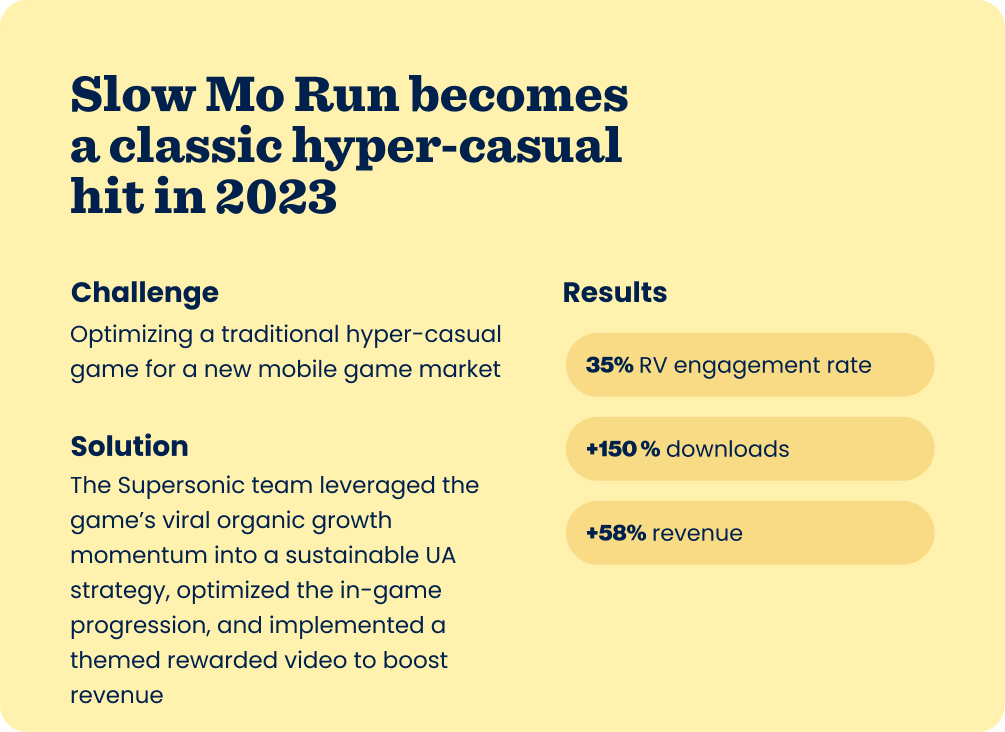Canada-based developer and Founder of Pau Rau Games, Paul Raubic, recently published his third game, Slow Mo Run, with Supersonic. A spiritual successor to his previous Supersonic-published games, Move Animals and Move People, Slow Mo Run takes the core drag-to-move gameplay mechanic to the next level.
Slow Mo Run is a classic hyper-casual game in every sense - snackable, highly marketable, visually appealing, and compelling. Here, Paul dives into how Supersonic helped him create a hyper-casual hit in a challenging mobile game market.

The start of Slow Mo Run
In a lot of ways, Slow Mo Run is a successor to my previous games. Similar to those games, the core mechanic is to drag a character’s limbs to complete a movement. In Slow Mo Run’s core gameplay loop, the user is in control of a character that has to run up to an attacker while dodging projectiles. Once the player reaches the attacker, they drag the limbs of their character to punch and kick the enemy, defeating them.
One of the things which inspired the game was the winning creative we made for Move Animals. The creative featured a wolf and a bear fighting with the player controlling the animals by moving their limbs using the drag-to-move mechanic. I saw that there was a lot of potential for a game that used the drag-to-move mechanic in combat scenarios - and I also really liked the PVP style of gameplay.
I saw this as an opportunity to try something new and different from my previous puzzle games, a chance to develop a more dynamic and satisfying gameplay loop combined with the marketability and low CPI of a runner.
Iterating on a promising foundation
With the core concept ready, the Supersonic team and I got to work on prototyping and testing the game. The results that came back were promising. In the early version of the game, we achieved 1300s D0 playtime and a D1 retention rate of 36%, while also maintaining a CPI in the low thirties.

The game showed potential, so we got to iterating. In this phase, I knew I needed to do more with the mechanic in the iterations. So, I added new levels with the mechanics, like playing soccer (instead of kicking an enemy the player would need to kick a soccer ball into the goal while avoiding a defender). The soccer level later played a huge role in the success of the game. Other iterations included adding more enemies and refining the game’s story mode.
Still, the iteration phase proved to be challenging. We had taken on what seemed like a difficult task - to take a classic hyper-casual game and turn it into a hit in a highly-competitive and mature mobile game market.
A major turning point
Finally, we launched the game. We started slowly and with low expectations, but the game’s CPI stayed competitive and we managed to achieve 65% D0 ROAS. I assumed that the game would be a mid-tier success - enjoying decent but not amazing returns as a more traditional hyper-casual game in a challenging market. Yet, I was committed to developing the game and doing whatever it took to make it work (partly just because of how much I loved the game).
What I hadn’t accounted for was the organic marketability of a strong, classic hyper-casual game. One of our users took a screen capture of them playing the soccer level and uploaded it to TikTok. The clip went viral, reaching 1.2 billion views and the game’s growth exploded.
The difference between a flash in the pan and a blazing success
The help of the Supersonic team made all the difference here, they took the momentum from the viral clip and turned it into a sustainable creative campaign strategy. And it wasn’t just the creatives that got a soccer make-over, the team also updated the app icon with the new soccer theme. We then got to work on optimizing the in-game level progression so that users could get to the soccer level sooner (but not too soon).
With the game’s viral success, the Supersonic growth team then switched from non-optimized campaigns to run on ironSource Ads and Unity Ads optimized campaigns. They also expanded our campaigns to new countries, adding APAC and other tier-2 regions. The result was a 150% increase in downloads.
Another addition was a special soccer level that was only accessible through a rewarded video, which raised the rewarded video engagement rate to over 35%. Ultimately, this all led to a huge boost in revenue of 58%.
A lot of credit for Slow Mo Run’s success goes to the Supersonic team. They were there from the beginning, helping to optimize the game from prototyping onwards. Without their assistance, I’m not sure how far we would have gone. The team knew just how to leverage the game’s organic marketability into a sustainable hit, ultimately proving that a good classic hyper-casual game can still be a blazing success.
Let's put these tips to good use
Publish your game with Supersonic




